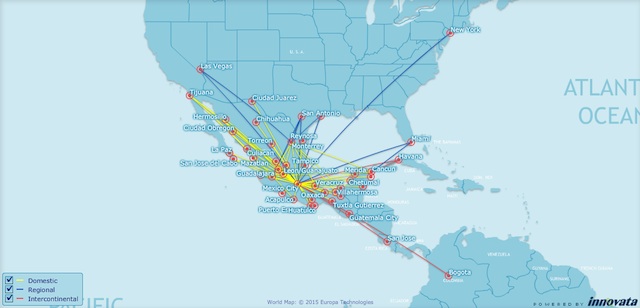Mexican carrier Interjet expects to substantially grow its US network when a new bilateral air services agreement takes effect in 2016, while also expanding further in Latin America.
Interjet chief executive Jose Luis Garza told Flightglobal in a recent interview in Mexico City that the airline could add four to five new US destinations, after a liberalised agreement between the USA and Mexico eliminates restrictions on the number of airlines that can serve on routes between the two countries.
The airline serves only five US destinations currently: New York John F Kennedy, Miami, Houston Intercontinental, San Antonio and Las Vegas. On the carrier's wish list for quite some time is Los Angeles, which Garza says Interjet still maintains interest in.
Interjet stopped serving Orange County in 2014, citing insufficient demand. The airline cannot currently serve Los Angeles from Mexico City, because Aeromexico and Volaris hold the two available Mexican designations for that route. But in 2016, the new liberalised air services agreement will lift these restrictions.
"We will wait for Los Angeles to open up," says Garza. He also expresses interest in flights to the San Francisco Bay area.
Garza says the airline foresees it would need to acquire five to six additional Airbus A320s for the expected growth in new flights to the USA. Interjet operates a fleet of 39 A320s and 16 Sukhoi Superjet 100s, Flightglobal's Ascend Fleets shows. The additional A320s will help Interjet grow its US network, since the carrier does not foresee taking new A320 family aircraft until 2018, when it takes delivery of its first A320neo.
"There will be good opportunities in the international market," says Garza. "But we can't commit until we get clear signals."
Garza's "clear signals" refers to the impending formal ratification of the updated US-Mexico air transport agreement, which has to take place although both countries have indicated they expect the agreement to take effect from January 2016.
Interjet's expansion in the USA has been gradual, compared with rival Volaris' rapid growth in Mexico's northern neighbour. Most recently, Interjet added another US route with nonstop service between Mexico City and Houston Intercontinental. The airline is operating on the route on an extrabilateral basis after the USA and Mexico agreed to allow Southwest Airlines to commence service under the same conditions between Mexico City and Houston Hobby in October. Aeromexico and its regional carrier had held the two available Mexican designations on the route.
Garza says the right to operate to Houston from Mexico City was an important victory for Interjet, and that the route has been "very successful" for the airline. Interjet had already operated to Houston from Monterrey.
The airline has also recently upped frequencies to some of its US destinations, like going to twice daily from once to New York JFK and growing to thrice daily from twice to Miami. Both routes are served out of Mexico City, although Interjet has also in the past year begun nonstop service to Miami from Cancun.
"We are extremely successful in markets like Miami," says Garza. "Our brand is well-known, not only in Mexico but in those destinations."
Interjet route map

Innovata FlightMaps Analytics
Outside of the USA, Interjet has aspirations to grow further south into Latin America and also sees potential in the Caribbean. The airline's furthest south point in its network is Bogota, but Garza says Lima and Quito are cities that the airline aims to serve. Interjet is also keen on adding additional points in Colombia, with Medellin and Cartagena the most likely choices.
"Lima is at the top of our list," says Garza. The airline recently signed a codeshare agreement with Chile's LAN, which has a subsidiary in Peru. LAN Peru is the South American country's largest airline.
Garza points out that there are not many other Latin American countries within the range of the A320 that it could potentially fly to. "Venezuela is out of the question," he says, referring to the country's economic troubles and protectionist policies. Panama will be "complicated" since Copa Airlines has such a strong position in its home country, adds Garza.
Interjet already has a limited presence in Central America, where it flies to Guatemala City and San Jose.
Garza says the airline could further grow in the Caribbean. Besides Mexican leisure destinations like Cancun, Interjet also operates to Havana. "Cuba is working very well for us," says Garza. "We used to have just one flight a day, and now we have two."
The airline flies to the Cuban capital from both Mexico City and Cancun. It launched the Cancun service in July.
Garza says Interjet will study other Cuban destinations like Varadero, a beach resort town.
Source: Cirium Dashboard






















